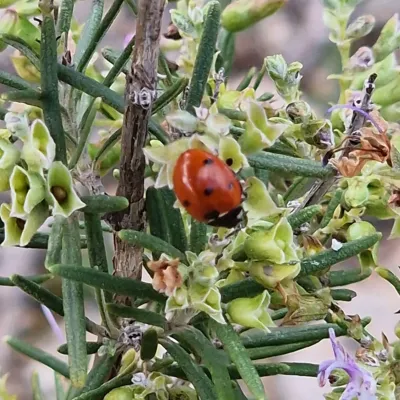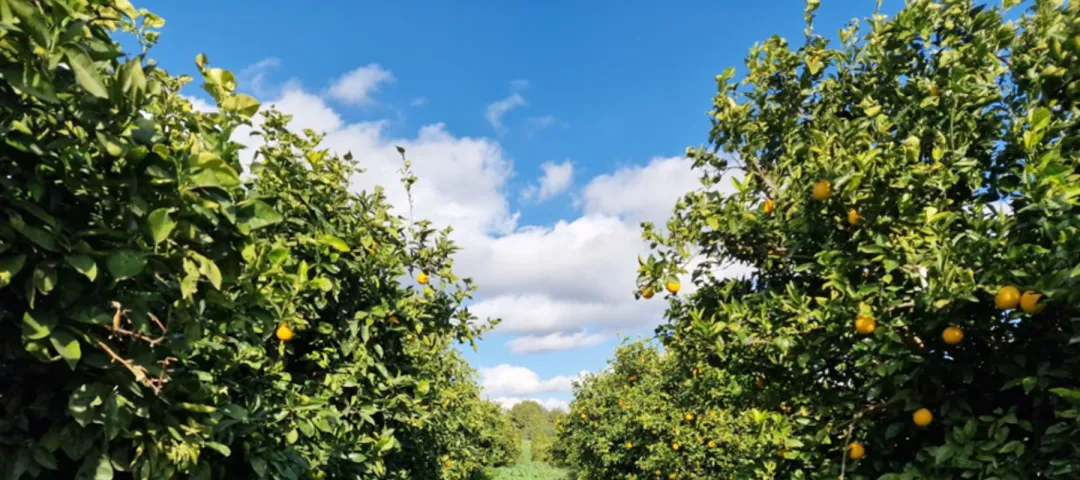General information
RDP Priority
- P1. Knowledge transfer and innovation
RDP Focus Area
- 1A: Innovation & cooperation
RDP Measure
- M16: Cooperation
Beneficiary type
- Partnership
Summary
Led by the Polytechnic University of Valencia (UPV), in collaboration with the RuralFruit cooperative, Anecoop, and Federació de Cooperatives Agroalimentàries de la Comunitat Valenciana (FECOAV), this project aimed to demonstrate the benefits of cover crops in Mediterranean citrus farming. The initiative emerged from an urgent need to find sustainable alternatives to synthetic herbicides and tackle rising pest pressures, especially from Delottococcus aberiae, an invasive mealybug species that causes severe damage in citrus orchards.
Demonstration plots were established in two orchards in the Valencia area (Museros and Pedralba), where cover crops, floral strips and hedgerows were introduced. These interventions were studied for their effects on soil health, pest dynamics and biodiversity, revealing how different vegetation types influenced beneficial insect populations, particularly parasitoids. Complementary actions included soil moisture monitoring, organic matter analysis, and pilot apiculture through on-farm hives producing high-quality citrus honey.
Knowledge transfer played a role in promoting the adoption of agroecological practices, with the project reaching hundreds of growers and technicians through field visits, technical workshops, articles, videos and social media.
Results
- Τhe project demonstrated that simple ecological practices like cover cropping can significantly strengthen natural pest control, enhance soil and water resilience.
- It also successfully showed that cover crops not only enhance ecosystem services, but also open new business opportunities for cooperatives. It now serves as a scalable model for agroecological transition in fruit production.

Promoter
Cooperative Rural Sant Vicent Ferrer
Funding
RDP support: 52 657 (EUR)
EAFRD: 27 908 (EUR)
National/Regional: 24 749 (EUR)
Ressourcen
Context
The Ruralfruit-Agroeco project is promoted by a multidisciplinary partnership led by the Mediterranean Agroforestry Institute (UPV), in close collaboration with the Rural Fruit Cooperative of Benaguasil, Anecoop S. Coop, and the Federation of Agri-food Cooperatives of the Valencian Community (FECOAV). The initiative is a continuation of previous trials in which vegetable soil covers were implemented on fruit crops. These earlier projects demonstrated the potential of cover crops as a simple, cost-effective tool for pest control and soil improvement, especially under Mediterranean farming conditions.
The need for the project was rooted in the serious threat posed by Delottococcus aberiae (South African ‘cotonet’), an invasive pest that has rapidly spread across citrus orchards in Valencia, causing significant fruit deformities and yield losses. Traditional chemical control was losing effectiveness and becoming environmentally damaging. Moreover, the region faces severe challenges derived from climate change, including extreme rainfall events and prolonged droughts, which exacerbate soil degradation and erosion risks.
Beyond ecological objectives, Ruralfruit-Agroeco placed strong emphasis on participatory governance and knowledge dissemination. Local technicians, researchers, and farmers closely collaborated in decision-making, monitoring and the execution of trials. The cooperative’s demonstration fields also enabled outreach to a broad spectrum of producers, including more traditional farmers, helping to bridge generational and cultural gaps in the adoption of sustainable practices.
Objectives
The main objective of the project was to promote the transition from conventional to agroecological citrus farming in Valencian cooperatives, enhancing resilience to climate change. There were several specific objectives, including to:
- enhance biodiversity and natural pest control through ecological infrastructures.
- improve soil health and water retention by introducing cover crops.
- reduce the environmental impact of phytosanitary treatments.
- increase the competitiveness and sustainability of citrus farms.
- increase awareness and scale adoption of agroecological practices across the region.
Activities
Project activities included:
- establishing cover crops. Cover crops were used on 19.38 hectares of citrus orchards, comprising 13.71 hectares of spontaneous vegetation and 5.67 hectares sown. Additionally, hedgerows and flower strips were established to enhance plant biodiversity and the provision of ecosystem services.
- monitoring and evaluation of cover crops for pest management. In Museros, six cover crop species were evaluated against a control plot without vegetation. Results showed that Arbovert Perenne 1, which is a perennial plant cover consisting of a mix of species, including Festuca arundinacea, Dactylis glomerata, Bromus inermis, Onobrychis viciifolia, Vicia sativa, Trifolium alexandrinum, and Sinapis alba, demonstrated higher adaptability to drought conditions, significantly increasing parasitoid populations used in biological pest control. In Pedralba, trials included the augmentative release of green lacewings (Chrysoperla spp.) and the replacement of acetamiprid with mineral oil treatments. These trials showed beneficial effects against natural enemies.
- applying integrated pest monitoring and management. Focused monitoring of critical citrus pests, particularly Delottococcus aberiae and aphids, was conducted. Findings highlighted that the presence of cover crops substantially reduced pest populations, attributed to an increased presence of braconid parasitoids, which kill pests at early stages.
- conducting trials of environmentally friendly pest control products. Preliminary trials were conducted to assess the augmentative release of green lacewings for the control of D. aberiae. These trials indicated a temporary reduction in pest populations, with final pest levels lower than those achieved with traditional chemical pesticides. Nevertheless, further experiments with adjusted dosages and treatment frequencies are required to optimise this biological control approach.
- developing a comprehensive citrus pest management strategy. The results of the trials contributed to the design of a comprehensive pest management strategy, providing evidence on how specific cover crop management practices, such as mowing frequency and species selection, can enhance the activity of natural enemies such as parasitoids. The studies also revealed the negative impact of chemical pesticides, such as acetamiprid, on beneficial organisms such as ladybirds, underscoring the importance of minimising chemical interventions.
- evaluating the influence of cover crops on water management. Water dynamics were assessed using capacitive probes and moisture sensors to compare soils under plant cover against bare or herbicide-treated soils. Soils with cover crops exhibited increased organic matter content, higher enzymatic activity, improved structure and drainage, reduced erosion and better water retention capacity.
- installing beehives for study. Six beehives were installed at the Pedralba farm to explore the additional ecosystem services provided by these ecological infrastructures. The honey they produced demonstrated superior organoleptic properties, including freshness, optimal colour, low hydroxymethylfurfural (HMF) levels, and good diastase activity, all highly desirable attributes in high-quality citrus honey.
- disseminating project results and transferring knowledge. A comprehensive dissemination strategy was implemented, including informative sessions, field visits, and technical seminars targeting the cooperative’s members. Outputs included one bachelor's thesis, one master's thesis, two scientific posters presented at national conferences, articles in Agricultura y Cooperación magazine, and three outreach videos. Results and project updates were shared extensively via institutional websites and social media channels. Additional educational activities, such as school workshops and on-site information signage, were deployed to promote wider adoption of ecological interventions.
- involving stakeholders. The Polytechnic University of Valencia led and coordinated research activities, supported by participatory decision-making sessions. The Rural Fruit Cooperative, through its project technician, actively implemented and managed field operations. ANECOOP contributed significantly through dissemination activities and hosted demonstration trials, while CVCA facilitated extensive outreach via their robust cooperative network.
Main results
- Ultimately, the project responded to both ecological and socio-economic needs by improving pest management, enriching biodiversity, enhancing soil health and water retention, and reinforcing cooperative-based agricultural models in the face of environmental and market challenges.
- Cover crops were successfully introduced across 19.4 hectares of citrus orchards belonging to cooperative farms: 13.7 hectares of spontaneous vegetation and 5.7 hectares were sown with diverse seed mixes. In addition, flower strips, hedgerows and biodiversity islands were established as complementary landscape features. Notably, studies on the cover crops revealed their distinct botanical and insect profiles, enabling researchers to differentiate between seed mixtures with an accuracy of 98.2%.
- In the challenging drought conditions of the Museros site, two cover-crop mixes, Arbovert Perenne 1 and Diversity Grow - seed mixes that are designed for Mediterranean conditions - proved exceptionally resilient, thriving throughout the dry season. Remarkably, these covered areas hosted 50% fewer aphids and invasive Delottococcus aberiae compared to areas without vegetation. Additionally, these vegetated areas experienced earlier and stronger activity of beneficial insects such as braconid parasitoids, allies in natural pest control.
- Soil monitoring revealed significant improvements, as rows with cover crops retained 25–30% more moisture for up to 48 hours after rainfall events. Laboratory analyses further supported these benefits, recording a notable 32% increase in soil organic carbon and a 28% boost in soil enzymatic activity. This greatly enhanced soil structure and water infiltration capabilities. In Pedralba, simply removing herbicides and encouraging spontaneous vegetation led to a 40% reduction in captures of male mealybugs on citrus trees. Moreover, experiments releasing green lacewings, a beneficial insect predator, showed a promising ability to suppress mealybug populations more effectively than conventional pesticide treatments, highlighting the potential for pesticide-free pest management once methods are fully optimised.
- As part of a pilot trial, five beehives were installed in Pedralba to explore the potential for complementary income sources. The hives produced 110 kg of premium-quality citrus honey, characterised by exceptionally low HMF levels (less than 5 mg/kg) and optimal diastase activity (16 Gothe units). While still at a preliminary stage, the results suggest potential for new cooperative products linked to agroecological practices
- Extensive knowledge transfer efforts reached over 350 growers, technicians and students through multiple formats, including six field visits, six workshops, two scientific posters, three articles in trade journals, two professional-quality videos, and active engagement via social media.
- Looking ahead, by 2027, partner cooperatives aim to expand these practices to over 100 hectares and plan to create two new full-time agroecology technician positions to meet the growing advisory demand.
Key lessons
- One of the lessons from this project is that soil health plays a central role in sustainable pest management. With the increasing restriction of synthetic pesticides under EU regulations, living soils rich in organic matter and with biological diversity can significantly limit pest outbreaks, especially those with a soil-dwelling phase like Delottococcus aberiae or thrips. Cover crops proved essential for improving both biological control and climate resilience.
- The project demonstrated that coordination is crucial in multi-actor initiatives. Having a dedicated project coordinator to manage tasks and facilitate collaboration was essential to ensuring success. The synergy between researchers, cooperatives and technical experts added tremendous value, enabling both scientific innovation and real-world application.
- The most surprising outcome was the ability to distinguish cover types solely by their insect communities using multivariate analysis, a clear sign of ecological functionality. In addition, the severe droughts during the 2022 and 2023 campaigns highlighted the need to adapt implementation plans to increasingly unpredictable climate conditions.
- For anyone considering a similar project, the project holders recommend starting with small-scale trials while maintaining a long-term vision. It is also important to design for simplicity, involve local stakeholders from the outset, and design management practices that can adapt to changing environmental and agronomic conditions. When well executed, these green infrastructures, such as cover crops, provide a low-cost and high-benefit tool to enhance sustainability in Mediterranean agriculture.
When we started, 80% of the fruits were damaged by the pest; now there’s barely any damage. It’s impressive, it proved highly effective.
Cover crops not only help manage pests, they also improve soil structure and make it more resilient to climate change.
Dra. Rosa Vercher Aznar

